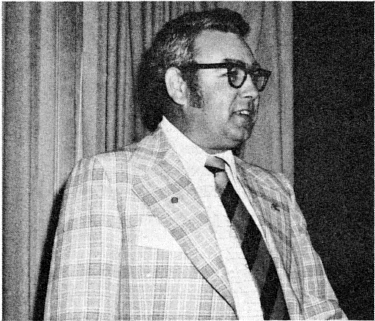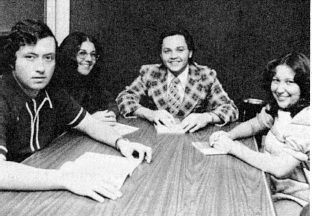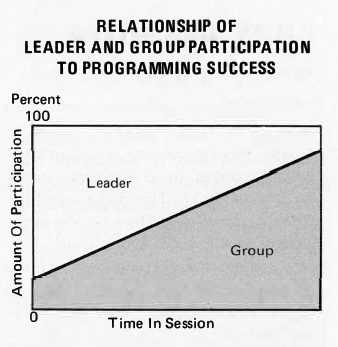
(Editor’s note: Perhaps more than any other element, programming can mean the difference between success and failure in a local chapter’s continual effort to survive and prosper. Innovative, meaningful meeting programs help keep attendance strong and also attract new members. So that other chapters can benefit from their experiences, the presidents of four chapters with strong programming policies and the executive director of S.A.M., Donald Begosh, all give their views on what makes successful programs.)
E. E. Thompson, Jr., President, Central Virginia Chapter. The Central Virginia chapter of S.A.M. encompasses a large area, including several counties and cities, which are separated by the scenic Blue Ridge Mountains. Since we do cover such a large area, and since our membership represents many varied interests, programming is of utmost importance to the success of our chapter.

Informative as well as interesting programs must be presented in order to provide a stimulating forum where members can share their knowledge and to create a working relationship in which individual expertise is given freely among members.

“The purpose of an S.A.M. program meting… is to bring a group of managers together to gain information and exchange ideas and experiences.”
I believe that fellowship is one key ingredient for a successful meeting, and our social hour, which starts at 6 p.m., helps supply that ingredient. The social hour allows the officers to mingle with members and personally meet all visitors. (This is a must! After all, all visitors are prospective members.) Following the social hour, we have our meal and I, as chapter president, make a few brief remarks before the membership vicepresident introduces our visiting guests. The meeting is then turned over to the evening chairman, who introduces the speaker. Speaker presentations are about 20 to 30 minutes in length, following which questions are answered by the speaker. We devote one program each year to our University of Virginia student chapter, which chooses and presents its topic in the form of a panel discussion.
Proper selection of subject matter, coupled with the best qualified speaker available, is the ideal combination for a successful meeting program. Controversial subjects are highlighted in as many programs as possible to create interest and encourage member participation during the question-andanswer period. This procedure has worked well, as the fact that some question-and-answer periods have exceeded the time taken to present the topic seems to indicate. A steady diet of work-related programs to round out an already full work day does not fill the needs of modern managers, nor do these programs hold their interest. It is necessary to challenge managers on subjects that are topical, nonwork related, and worthy of their consideration.
Finally, don’t be afraid to try innovative ideas! Often a new and exciting concept fails to interest a group of managers because the way in which it was presented was old and humdrum. If you’re unable to come up with a new method of presentation, get your programming committee together and “brainstorm” the problem. Remember, the key to chapter success is good programming, and the key to good programming is an exciting concept and presentation.
Melvyn B. Wolf, President, Chicago Chapter. Our chapter is currently experiencing increased attendance at monthly dinner meetings and more participation by all of our members in the operation of these meetings. There is no simple formula or recipe for successful chapter meetings, but we have found there are certain actions that can improve the probability of success. Some of these are listed below.

Advance program planning. Start thinking about next year’s programming in December and January. Have a questionnaire prepared and distributed at your monthly meetings and to everyone on your mailing list. (Since we are a nonprofit organization, it only costs us a few dollars per month to communicate upcoming activities to the 300 people on our mailing list.) Using the questionnaire, solicit members’ ideas and speaker recommendations.
Telephone call plan. One week prior to each meeting, we activate our telephone call plan, with our officers reaching nearly every member of our chapter. These calls not only serve to remind members of the upcoming meeting, but they also provide an opportunity to find out what the members are thinking about the programming and the chapter in general. You would be surprised how appreciative your members are that you would take the time out of your busy schedule to give them a reminder call. Meeting evaluation forms. We have devised a meeting evaluation form to be filled out by members at the conclusion of the monthly dinner meeting. Comments made on the program, facility, food, and other aspects of the evening are utilized by the officers in planning future meetings.
Chapter yearbook. Each year we print a yearbook containing the following information: the president’s message, officers and board of directors listing, the complete program for the coming year (September through June), a roster of all members indicating their position, company, business and home addresses, and a listing of all companies represented in our chapter. The yearbook is used for publicity purposes throughout the year; it also helps to finalize program subjects and speakers before the first meeting is held, and it acts as a handy reference for our members.
Special meetings. You will find that including two or three special meetings in your yearly programming contributes to a healthier program atmosphere. In recent years, our monthly meetings have included special meetings devoted to women in management, student chapters, our “Manager of the Year” award, and a management seminar.
(Melvyn Wolf is manager of industrial engineering at the Midwest Stock Exchange in Chicago.)
Walter Kassebohm, President, San Francisco Chapter. The success and growth of an S.A.M. chapter depend to a large degree on the type of programs that are offered at the monthly meetings. These programs must be presented by competent and knowledgeable speakers. The subjects should fall within the wide scope of today’s managerial problems and should be of a variety that fits the many diverse interests of the chapter members.
It is, therefore, of great importance that each chapter has a vice-president of programs who has the ability and the time required to make conclusive arrangements with a number of speakers throughout the year. The vice-president should get assistance from a program committee that he selects.
The San Francisco chapter has followed these procedures for several years and has consequently provided interesting monthly meetings on a variety of timely managerial problems and solutions. The directors of the chapter each year give the vice-president of programs a general theme to follow that is in line with the general management problems of the time. For the year 1975-76, the general theme has been “Positive Management in a Negative World Economy.” This theme allows discussions about the many difficulties in dealing with inflation, deflation, restrictions through law or economics, reductions of productivity or workforce, and many other national and international questions of our time. There is no shortage of stimulating subjects to enhance an S.A.M. meeting and at the same time give practical solutions to common problems.
The key to programming success is a good vice-president of programs and a good program committee. They, in turn, must be backed up by an active board of directors that is willing to put in a little extra time and effort in making contacts with outstanding speakers.
The vitality and growth of an S.A.M. chapter directly reflect the presentation of programs at monthly meetings. Careful planning in this respect is, therefore, a must; the results of good programming are creative and stimulating meetings, and high attendance records.
(Walter Kassebohm is retired from his position as vice-president of the SCM Corporation.)
Jesse Ponce, President, Western New Mexico University Student Chapter. The overall programming objectives of our chapter meetings are established at the beginning of the academic year. The number of activities to be undertaken and the approximate time when the activities are to be held are determined. The open agenda at the first meeting is designed to give each member an opportunity to voice his or her program ideas, and these ideas are then given serious consideration by the executive committee (consisting of the president, vice-president, treasurer, secretary, and editor of the newsletter) as to their feasibility and probability of success. With this input of the members, the executive committee settles on a final outline of programmed activities and presents this outline to the members for their approval at the next meeting.

For each programmed activity, a committee is chosen. The members of the committee (which is headed by a chairperson and cochairperson) have total authority and responsibility over their particular activity. Since the activities are planned well in advance, the probability of success is very high.
At the Western New Mexico University chapter, we believe in “membership centered management.” We believe that, given enough time, planning, and responsibility, all our activities can and will be successful.
Donald Begosh, Executive Director of S.A.M. SuccessfuI programs are the lifeblood of an S.A.M. chapter; many of the contributors in this issue have attested to this fact. Yet, we often come across the paradox of a good program year that is met with low attendance. Why this occurs is not an easy question to answer. Let me share some tips with you that may help you overcome the problem of low attendance in the midst of good programming.
Member participation. In our efforts to analyze low attendance, we should review the purpose behind an S.A.M. meeting/program. To me this purpose is to bring a group of managers together to gain information and exchange ideas and experiences. To accomplish this, it is essential that the meeting emphasize member participation. It has been shown that the key to learner interest is the amount of active participation he or she has in the learning process. This active participation can be the bridge to applying a new technique on the job. Management education is action oriented; new ideas are springboards to action.
Many chapter programs overlook this important point. Our program planning time is usually concerned with the selection of topic and speaker. Since our meetings are usually dinner programs, we assume that a lecture format must be used. This is not so. We can use case studies, panels, and workshops, all of which are geared to strong member participation.

The ultimate success of any program lies with the speaker’s ability to get members to participate. At first, the speaker’s job is to present a new concept, idea, or problem; this is the part of the program where he or she is most active. At this point, the speaker is merely transmitting information (See graph). However, as the program continues, the members of the audience should become more actively involved, not only with the speaker, but also with other audience members. Finally, toward the end of the program, the speaker’s only function should be to continue to stimulate this group participation and interaction. Experience has shown that the exchange of experiences among S.A.M. members at a program will lead to greater idea-sharing outside the program; this, in turn, helps to build a stronger chapter.
Program R.O.I. S.A.M. programs are a form of management education. And since our members, when they attend a meeting, are investing their time and money, they expect a “pay-back” or return-on-investment, just as any investor does. The bottom-line result of any management education program is to help the individual perform better in his or her daily job. SAM-NI
This SAM News International article is from our historical archive, information provided is for reference and archival research about the activities and developments of the Society.
